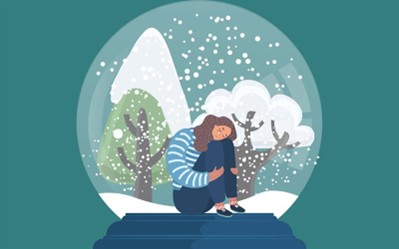The Month of Not-so-Merry Mental Health
It’s the most wonderful time of the year once again, although as the holidays and winter approach, seasonal affective disorder (SAD) climbs to an all-time high in the United States. Why does up to 10% of the U.S. population suffer during this time and how can we overcome these feelings?
SAD is form of clinical depression. According to the National Institute of Mental Health (NAMI), symptoms of SAD include feelings of depression, lack of interest in activities you have previously enjoyed, changes to your appetite or weight, sluggishness and low energy, and trouble falling asleep or oversleeping during the day. While most experiencing this form of depression have winter-pattern SAD, there are some who may suffer from summer-pattern SAD.
Winter seasonal affective disorder is triggered by the lack of sunlight during autumn and winter. Daytime is shorter and the cold discourages outside activity. Limited exposure to natural light can result in neurochemical imbalances that cause feelings of depression.
Melatonin is produced to promote sleep. In someone without SAD, melatonin is produced at night and concentration declines as sunrise approaches to help wake up the individual. In those with the disorder, melatonin is at its pinnacle later in the night and lingers into later hours of the day. This causes insomnia and exhaustion.
Not only this but, holidays and the social interactions and celebrations that come along with them can cause a lot of anxiety for those who already have mental illnesses. NAMI reported that up to 64% of people with preexisting mental health issues found their conditions exacerbated during the holiday season.
Not everyone with these symptoms may have SAD, but winter blues is no stranger to those in more northern areas of the United States. So, how do you stop feeling this way? Of course, you can see your doctor or a therapist regarding a treatment plan, but there are a couple alternative DIYS that have proven to help with the symptoms of winter-pattern SAD and winter blues.
This first approach adds back in the lack of sunlight we see during the winter season. “Bright light treatment first thing in the morning dramatically improves the vast majority of people with seasonal affective disorder,” Dr. Paul Desan, a psychiatrist at the Yale School of Medicine said.
This phenomenon involves sitting in front of a light therapy box, which simulates natural light, for 30 minutes every morning when you wake up. It allows those who use it to produce the proper hormones to increase alertness. The type of lamp you buy for your therapy is crucial, as you want it to mimic natural sunlight as accurately as possible. Dr. Desan’s Yale lab provides a list of lamps here.
Finally, although it may be freezing, go outside! Regardless of the conditions, being in nature can boost your mental health and give you a sense of serenity.
Winter and the holidays are trying times for most. Remember that your mental health matters and be sure to carve in some time for self-care!







